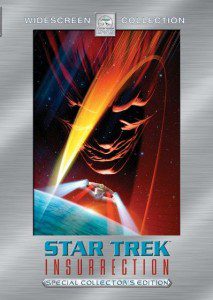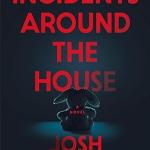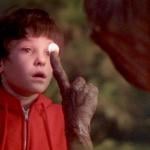 Star Trek: Insurrection (1998) was easily one of the most inconsequential films in the entire Star Trek franchise, and, oddly enough, the new “collector’s edition” DVD makes it seem like even less of an event.
Star Trek: Insurrection (1998) was easily one of the most inconsequential films in the entire Star Trek franchise, and, oddly enough, the new “collector’s edition” DVD makes it seem like even less of an event.
For one thing, this is the first two-disc set in the entire series that has no audio commentary track whatsoever — not by the writers, not by the director, not by anybody; instead, all it’s got is the requisite snarky text commentary by Michael and Denise Okuda. (No Star Trek DVD is complete without it!)
For another, the bonus features keep reminding us that this was the first film since William Shatner’s The Final Frontier (1989) that did not rely upon ILM for its effects, or that this film may have beat the record set by The Final Frontier for the biggest set ever built for these films, and so on. And since The Final Frontier was easily the most inconsequential, embarrassing and forgettable film that starred the original cast, that’s the sort of association one would probably not want to be making all the time.
The story goes that, after the dramatic and thematic intensity of First Contact (1996), the Next Generation crew wanted to do something lighter and fluffier, and it shows. But instead of making a time-travel comedy like The Voyage Home (1986) or a straightforward romance or exploring any of a number of story possibilities that were bandied about every week on the original TV show, they fell victim to the mentality which holds that every sci-fi movie must, of necessity, be a space-battle movie. And so, instead of making an action movie with conviction a la First Contact, they made a half-assed action movie instead.
Indeed, the defining moment in this film, for me, has always been the scene where the “drones” find our heroes, and the people and the machines just stand there and look at each other, like they don’t really believe that there’s anything all that big at stake or anything all that threatening going on, so they have time to pose before they start zapping each other again. Utter dullsville.
To be sure, there are some interesting ideas at play here. Michael Piller, who wrote the script with producer Rick Berman, says he wanted to write a story that got back to Gene Roddenberry’s “optimistic” view of the future, but he sure picked an odd way to do it — the story is all about how the Federation, forced to do anything to ensure its survival, gets involved in extremely murky and deceptive interplanetary dealings, and how it is up to Picard and his closest friends to defy the Federation for the sake of higher principles. This sort of thing is certainly very much in the spirit of Roddenberry’s original series — remember the episode where Kirk came up against a Starfleet officer who was involved in a Vietnam-like conflict on another world? — but how it reflects an “optimistic” view of the future is a little beyond me.
It’s also a shame that the screenplay zips by some of the most interesting bits of dialogue in order to get back to the action, the action. The situation in which Picard finds himself is open to a number of moral interpretations, but the film is too eager to keep things simple: the Ba’ku are good guys, period, while the Son’a are bad guys, period (except for the guy who turns against them after a particularly stern bit of speechifying on Picard’s part).
Patrick Stewart says in one of the extras that one of the film’s key themes is, “Is it always acceptable that the good of the many should be used to overwhelm the needs of the few?” That’s an interesting new spin on one of the key questions behind The Wrath of Khan (1982) and The Search for Spock (1984), but one question nobody really asks is whether the Ba’ku really do “need” to remain on this planet, which they happened to colonize a few hundred years ago. That might have been interesting to explore.
Still, ya gotta love Picard’s moral absolutism, in the scene where the vice admiral says, C’mon, the Federation’s plans will only affect 600 people, and Picard replies, “How many people does it take before it becomes wrong? Hmm? A thousand? Fifty thousand? A million? How many people does it take, Admiral?” Moments like that give me just a taste of the Trek that I know and love. So does the score by Jerry Goldsmith; until today, I had not seen this film since its initial release, but I have listened to the soundtrack repeatedly, and it was interesting to see which long-forgotten visuals had inspired the music that I know so well.
Inevitably, when watching a film for the first time in years, you start to think about all the other memories you associate with the era in which the film was made. This is especially true with the Star Trek movies, which came out regularly at two- to four-year intervals between 1979, when I was in grade four, and 2002, when I was a full-time freelance writer living with my brother in downtown Vancouver; each film marks a different phase in my life. It’s interesting to think that this was the last film that came out before I moved out of Surrey, or that it was the first film that came out after the youngest of my siblings had finished high school, or that it was the first film that came out after I left university behind me for good, or that I wrote an article on this film that was one of the earlier pieces I sold to a non-student publication.
Insurrection feels like it was made yesterday, but actually, quite a bit has happened since then. Time does fly. Which is kind of an interesting reaction to have to a film in which characters find “the fountain of youth” and learn how to stop time in its tracks!
JUNE 17 UPDATE: I forgot to mention one thing — at 103 minutes, Insurrection is also the shortest of all the Star Trek films. And despite its brevity, it still feels a little padded. That’s just one more thing that makes the movie feel so easy to dismiss.












